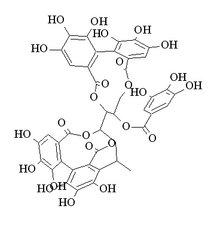
Tannins are a class of astringent, polyphenolic biomolecules that bind to and precipitate proteins and various other organic compounds including amino acids and alkaloids.
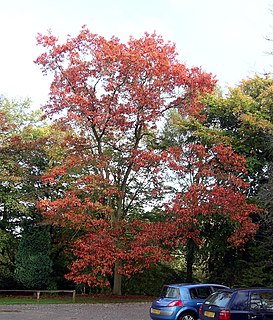
Quercus rubra, the northern red oak, is an oak tree in the red oak group. It is a native of North America, in the eastern and central United States and southeast and south-central Canada. It has been introduced to small areas in Western Europe, where it can frequently be seen cultivated in gardens and parks. It prefers good soil that is slightly acidic. Often simply called red oak, northern red oak is so named to distinguish it from southern red oak (Q. falcata), also known as the Spanish oak. Northern Red Oak is sometimes called champion oak.

Tannic acid is a specific form of tannin, a type of polyphenol. Its weak acidity (pKa around 6) is due to the numerous phenol groups in the structure. The chemical formula for commercial tannic acid is often given as C76H52O46, which corresponds with decagalloyl glucose, but in fact it is a mixture of polygalloyl glucoses or polygalloyl quinic acid esters with the number of galloyl moieties per molecule ranging from 2 up to 12 depending on the plant source used to extract the tannic acid. Commercial tannic acid is usually extracted from any of the following plant parts: Tara pods (Caesalpinia spinosa), gallnuts from Rhus semialata or Quercus infectoria or Sicilian sumac leaves (Rhus coriaria).

Ellagic acid is a polyphenol found in numerous fruits and vegetables. It is the dilactone of hexahydroxydiphenic acid.

Quercitrin is a glycoside formed from the flavonoid quercetin and the deoxy sugar rhamnose.

Procyanidins are members of the proanthocyanidin class of flavonoids. They are oligomeric compounds, formed from catechin and epicatechin molecules. They yield cyanidin when depolymerized under oxidative conditions.
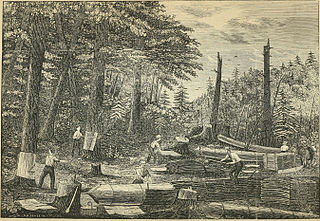
Tanbark is the bark of certain species of trees. It is traditionally used for tanning hides into leather.
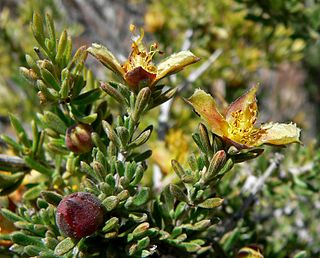
Coleogyne ramosissima or blackbrush, is a low lying, dark grayish-green, aromatic, spiny, perennial, soft wooded shrub, native to the deserts of the southwestern United States. It is called blackbrush because the gray branches darken when wet by rains. It is in the rose family (Rosaceae), and is the only species in the monotypic genus Coleogyne.

Quercus mongolica, commonly known as Mongolian oak, is a species of oak native to Japan, China, Korea, Mongolia, and Siberia. The species can grow to be 30 metres tall.
A hydrolyzable tannin or pyrogallol-type tannin is a type of tannin that, on heating with hydrochloric or sulfuric acids, yields gallic or ellagic acids.

Grandinin is an ellagitannin. It can be found in Melaleuca quinquenervia leaves and in oaks species like the North American white oak and European red oak. It shows antioxydant activity. It is an astringent compound. It is also found in wine, red or white, aged in oak barrels.
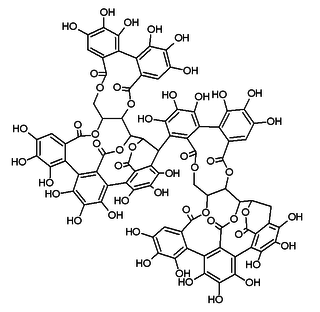
Roburin A is a tannin found in oak wood or oak cork.
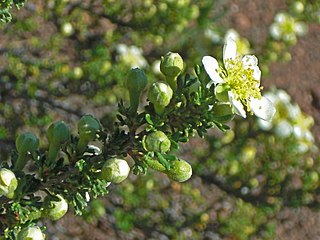
Purshia mexicana is a species of perennial flowering small tree in the rose family known by the common name Mexican cliffrose. It is native to western-northern Mexico, the region of the Sierra Madre Occidental cordillera.

Quercus infectoria or the Aleppo oak is a species of oak well known for producing galls that have been traditionally used for centuries in Asia medicinally while also used in softening leather and in making black dye and ink.
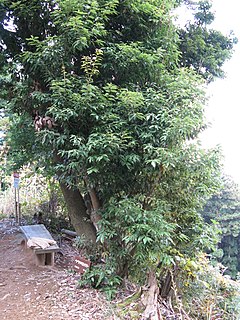
Quercus salicina is an oak species found in Japan, South Korea and Taiwan.
The Flavono-ellagitannins or complex tannins are a class of tannins formed from the complexation of an ellagitannin with a flavonoid. Flavono-ellagitannins can be found in Quercus mongolica var. grosseserrata.

Valoneic acid dilactone is a hydrolysable tannin that can be isolated from the heartwood of Shorea laeviforia and in oaks species like the North American white oak and European red oak.

Valoneic acid is a hydrolysable tannin. It is a component of some hydrolysable tannins such as mallojaponin.

Friedelin is a triterpenoid chemical compound found in Azima tetracantha, Orostachys japonica, and Quercus stenophylla. Friedelin is also found in the roots of the Cannabis plant.
The flora of the Colorado Plateau and Canyonlands region of the Western United States.
